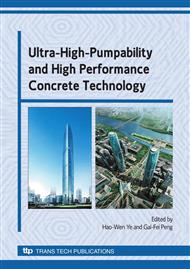[1]
AASHTO T259-1996. Standard Method of Test for Resistance of Concrete to Chloride Ion Penetration [S].
Google Scholar
[2]
C. ANDRADE, D. CERVIGÓN, A. RECUERO, et al. Calculation of Chloride Diffusivity in Concrete from Migration Experiments, In Non-Steady-State conditions [J]. Cement and Concrete Research, 1994, 24(7): 1214-1228.
DOI: 10.1016/0008-8846(94)90106-6
Google Scholar
[3]
TANG L., L. O. NILSSON. Predication of Chloride Penetration into Concrete By Use the Computer Program CLINCON [A]. Proceeding of 2nd International Conference on Concrete under Severe Condition: environment and loading, CONSEC'98 [C]. Tromso, Norway, 1998. 625-635.
Google Scholar
[4]
ASTMC1202-94. Electrical Indication of Concrete's Ability To Resist Chloride Ion Penetration [S].
Google Scholar
[5]
T. SUGIYAMA, Y. TSUJI., T. W. BREMNER. Determination of Chloride Diffusion Coefficient of High Performance Concrete by Electrical Potential Technique [A]. Proceedings Third CANMET/ACI International Conference on Concrete in Marine Environment, SP-163 [C], New Brunswick, Canada, 1996. 339-354.
DOI: 10.14359/1348
Google Scholar
[6]
AYE AYE KYI. An Electrical Conductive Method For Measuring the Effect of Additive on Effective Diffusivity In Portland Cement Paste [J]. Cement and Concrete Research, 1994, 24 (4): 752-764.
DOI: 10.1016/0008-8846(94)90201-1
Google Scholar
[7]
P. E. STREICHER, M. G. ALEXANDER. A Chloride Conduction Test for Concrete [J]. Cement and Concrete Research, 1995, 25 (6): 1284-1294.
DOI: 10.1016/0008-8846(95)00121-r
Google Scholar
[8]
Xinying LU. Application of the Nernst-Einstein equation to concrete [J]. Cem. Concr. Res, 1997, 27(2): 293-302.
Google Scholar
[9]
WIENS, U.; BREIT, W.; and SCHIESSL, P. Influence of High Silica Fume and High Fly Ash Contents on Alkalinity of Pore Solution and Protection of Steel Again Corrosion [A]. Proceedings of Fifth International Conference on the Use of Fly Ash, Silica Fume, Slag, and Natural Pozzolan in Concrete [C], American Concrete Institute, SP-153, 1995. 741-762.
DOI: 10.14359/1095
Google Scholar
[10]
Caijun SHI, JULIA A. Stegemann, Robert J. Caldwell. Effect of supplementary cementing materials on the specific conductivity of pore solution and its implication on the rapid chloride permeability test results [J]. ACI material journal, 1998, 95 (4): 389-394.
DOI: 10.14359/381
Google Scholar
[11]
GU Jiexiang. Zeolite[M]. Building Industry Press. Beijing, 1980. 1-3.
Google Scholar
[12]
WANG Jian, DONG Jialu, LIU Yang, et al. Studies on the Mechanism of Synthesis of Zeolite 4A from Metakalinite [J]. Chinese journal of inorganic chemistry, 2001, 16(1): 31-36.
Google Scholar


